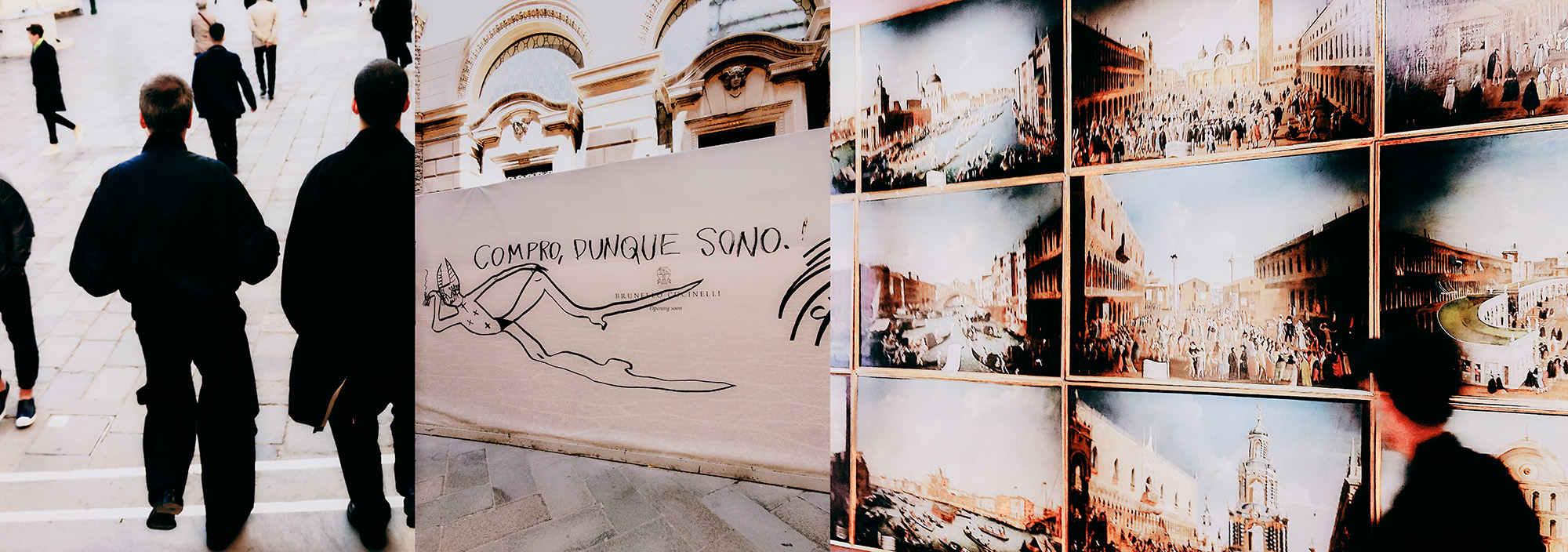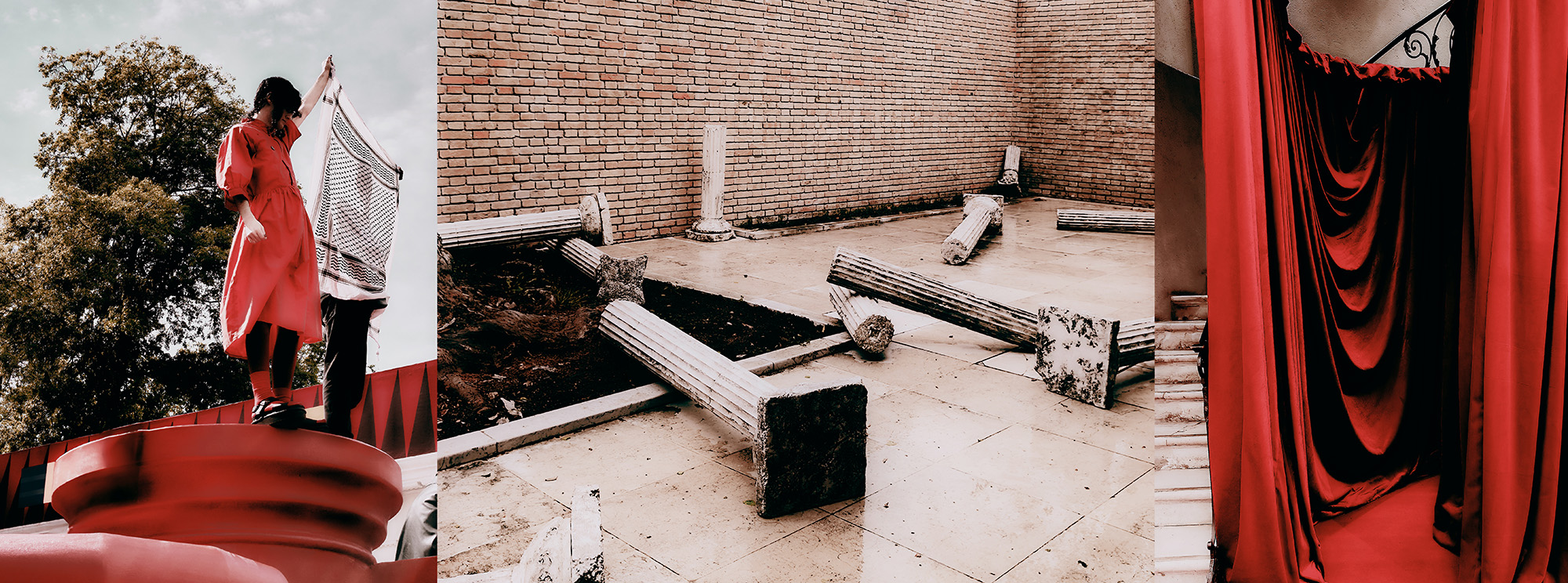Venice 2024: a visual essay of Biennale & city
In this exclusive visual essay, fashion photographer Carlo Zambon captured the opening week of Venice Biennale for recessed.space. Finding plenty of art across the city, Zambon also noticed the small moments, people & fashion that makes Venice Venice.
Every two years the Venice Biennale of Art takes over the lagoon city, saturating it not only with exhibitions but a whole whirlwind of surrounding culture and activity. With contemporary art secreted throughout palazzi, churches, and gardens as well as the main biennial sites of the Giardini and Arsenale, as an art visitor it can be easy to forget to notice the historic architecture and canals let alone the energy of visual activity that’s going on all over.
Always a hive of activity, over Biennale it can be a lot and hard to extract the city and its moments from the art, crowds, parties, and spritz. So we sent fashion photographer Carlo Zambon to the event’s opening week to create this exclusive visual essay, finding unexpected connections and new sightlines through the noise.
![]()
Anna Maria Maiolino’s To Infinity, from the series Modelled Earth (1994/2024) in Adriano Pedrosa’s main Venice Biennale exhibition at the Arsenale.
![]()
Raf Simmons, maybe heading to Fondazione Prada.
![]()
Yarema Malashchuk & Roman Khimei’s You are not Supposed to See This (2024), sleeping Ukrainian children who deported to Russia then returned to Ukraine, at Pinchuk Art Centre.
![]()
Pro-Palestine protestors from the Art Not Genocide Alliance standing atop Jeffrey Gibson’s plinth in front of the US Pavilion.
![]()
Reflections, a
Buccellati
boat & the Hotel Carlton on the Grand Canal.
![]()
tourists in awe.
![]()
A room in Aleksandar Denić’s Serbia Pavilion’s installation, Exposition coloniale.
![]()
The view towards Punta della Dogana from the Canale della Giudecca.
![]()
Protest leaflets from Art Not Genocide Alliance covering the Giardini.
![]()
A detail of Julien Creuzet’s presentation for the French Pavilion.
Always a hive of activity, over Biennale it can be a lot and hard to extract the city and its moments from the art, crowds, parties, and spritz. So we sent fashion photographer Carlo Zambon to the event’s opening week to create this exclusive visual essay, finding unexpected connections and new sightlines through the noise.

Anna Maria Maiolino’s To Infinity, from the series Modelled Earth (1994/2024) in Adriano Pedrosa’s main Venice Biennale exhibition at the Arsenale.
kith and kin, by Archie Moore for the Australian Pavilion.
New Human (2024) by Huma Bhabha, curated in the Julie Mehretu’s Ensemble exhibition at Palazzo Grassi.

Raf Simmons, maybe heading to Fondazione Prada.
“I shop, therefore I am” graffiti at the Brunello Cucinelli store.
Gabriel Bella’s Scenes from Venetian Life at the Fondazione Querini Stampalia.

Yarema Malashchuk & Roman Khimei’s You are not Supposed to See This (2024), sleeping Ukrainian children who deported to Russia then returned to Ukraine, at Pinchuk Art Centre.
An historic spun roundel window.
Waiting just behind the curtain of this age by Mark Salvatus for the Philippine Pavilion.

Pro-Palestine protestors from the Art Not Genocide Alliance standing atop Jeffrey Gibson’s plinth in front of the US Pavilion.
The external space of the Swiss Pavilion’s allegorical installation The Miracle of Helvetia and Roma Talismano, by Guerreiro do Divino Amor.
Balenciaga’s Venice store turned red to mark the celebrate the Rodeo bag.

Reflections, a
Buccellati
boat & the Hotel Carlton on the Grand Canal.
Shade outside the British Pavilion.
Carlo Scarpa detailing in the garden of the Fondazione Querini Stampalia.

tourists in awe.
“The technique, if successful, is that happy transmutation of the Lost into the Found, Junk into Art, the Neglected into the Wanted, the Unloved intothe Loved, Dross into Gold.” A Robert Indiana quote at Robert Indiana: The Sweet Mystery, at the Procuratie Vecchie.
A pallazo moth.

A room in Aleksandar Denić’s Serbia Pavilion’s installation, Exposition coloniale.
An aquarium in Pierre Huyghe’s Liminal exhibition at the Pinault Collection, Punta della Dogana.
A detail of the design by Isora x Lozuraityte Studio for Architecture for Inflamation, the Lithuania Pavilion by Pakui Hardware.

The view towards Punta della Dogana from the Canale della Giudecca.
The UNA/UNLESS-designed triangular exhibition space constructed by LAS Art Foundation in the Accademia di Belle Arti di Venezia for Josèfa Ntjam’s
swell of spæc(i)es installation.
A Bottega Veneta iPhone case.

Protest leaflets from Art Not Genocide Alliance covering the Giardini.
A detail of Willem de Kooning from an exhibition of his works at the Gallerie dell'Accademia.
Fritz (2024) by Diego Marcon in Fondazione In Between Art Film’s exhibition Nebula.

A detail of Julien Creuzet’s presentation for the French Pavilion.
The work of Ione Saldanha (1919-2001) in the Biennale main exhibition in the Giardini.
A visitor with Marni bag outside the US Pavilion.
Carlo Zambon is an Italian-born fashion photographer & art director based in London.
www.carlozambon.com
La Biennale di Venezia was founded in 1895 and is now one of the most famous & prestigious cultural organizations in the world. La Biennale, who stands at the forefront of research & promotion of new contemporary art trends, organises exhibitions & research in all its specific departments: Arts (1895), Architecture (1980), Cinema (1932), Dance (1999), Music (1930) & Theatre (1934). Its history is documented at the Historical Archives of Contemporary Arts (ASAC) that has been completely renovated in recent years. Since 1998 the Art Biennale & the Architecture Biennale are no longer simply exhibitions organised with the contribution of National Pavilions, but rest instead on three pillars: The exhibitions by National Pavilions, each with its own curator & project; The International Exhibition by the Biennale curator; Collateral Events, approved by the Biennale curator. This exhibition model has led to a pluralism of expressions: in order to accommodate them the exhibition spaces have grown for strategic needs, including an ambitious restoration of the Arsenale area which is still going on. The Art Biennale has been recognised as the world leader in contemporary art exhibitions & the countries participating have increased from 59 (in 1999) to 86 in 2017.
The Architecture Biennale has also been recognised as the best in the world.
www.labiennale.org/en
www.labiennale.org/en


